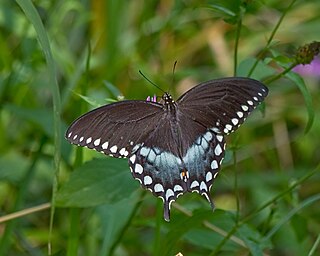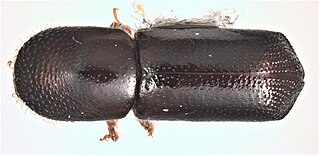
The bay leaf is an aromatic leaf commonly used in cooking. It can be used whole or in a dried or ground form.

Sassafras is a genus of three extant and one extinct species of deciduous trees in the family Lauraceae, native to eastern North America and eastern Asia. The genus is distinguished by its aromatic properties, which have made the tree useful to humans.

The flowering plant family Lauraceae, the laurels, includes the true laurel and its closest relatives. This family comprises about 2850 known species in about 45 genera worldwide. They are dicotyledons, and occur mainly in warm temperate and tropical regions, especially Southeast Asia and South America. Many are aromatic evergreen trees or shrubs, but some, such as Sassafras, are deciduous, or include both deciduous and evergreen trees and shrubs, especially in tropical and temperate climates. The genus Cassytha is unique in the Lauraceae in that its members are parasitic vines.

Papilio troilus, the spicebush swallowtail or green-clouded butterfly, is a common black swallowtail butterfly found in North America. It has two subspecies, Papilio troilus troilus and Papilio troilus ilioneus, the latter found mainly in the Florida peninsula. The spicebush swallowtail derives its name from its most common host plant, the spicebush, members of the genus Lindera.

Ocotea is a genus of flowering plants belonging to the family Lauraceae. Many are evergreen trees with lauroid leaves.

Cassytha is a genus of some two dozen species of obligately parasitic vines in the family Lauraceae. Superficially, and in some aspects of their ecology, they closely resemble plants in the unrelated genus Cuscuta, the dodders. When fruit and flowers are absent in the field, the physical resemblance is so close that few people without technical training can tell them apart. In this respect and in their ecology the two genera present a spectacular example of convergent evolution. Nonetheless, Nickrent comments that "Cassytha is uneqivocally assigned to Lauraceae based on (both) morphological and molecular data." In its divergence from habits typical of the Lauraceae, Cassytha also presents examples of mosaic evolution

Heritiera littoralis, the looking-glass mangrove is a large tree with wing shaped nuts, which is most easily recognised by the silvery scales on the underside of its leaves, which therefore appear green from top and white from below, although Litsea mellifera A.C. Smith, has the same type of leaves. The tree is usually found to grow along the seashore in Bangladesh & Indian Subcontinent, Southeast Asia and Tropical Africa.

Beilschmiedia is a genus of trees and shrubs in family Lauraceae. Most of its species grow in tropical climates, but a few of them are native to temperate regions, and they are widespread in tropical Asia, Africa, Madagascar, Australia, New Zealand, North America, Central America, the Caribbean, and South America. The best-known species to gardeners in temperate areas are B. berteroana and B. miersii because of their frost tolerance. Seeds of B. bancroftii were used as a source of food by Australian Aborigines. Timbers of some species are very valuable.
Ocotea argylei is a species of Ocotea in the plant family Lauraceae. It is a medium-sized to large tree 10–21 m tall, in some case to 30 m. Its status is classed as vulnerable. It is endemic to Kenya. The fruits are oblong berries which are covered by a cup-shaped cupule where they join the peduncle, giving them an appearance similar to an acorn. The leaves are elliptic with an acuminate tip. O. argylei is classified in the Flora of Tropical East Africa by the Royal Botanic Gardens, of Kew as Ocotea kenyensis (Chiov.) Robyns & R. Wilczek, with which it is possibly synonymous.

Ocotea porosa is a species of plant in the Lauraceae, often placed in the related genus Phoebe. It is commonly called imbuia or Brazilian walnut because its wood resembles that of some walnuts. The tree is a major commercial timber species in Brazil, used for high-end furniture, mostly as decorative veneers, and as flooring. The wood is very hard, measuring 3,684 lbf on the Janka scale. The wood is also fragrant with hints of nutmeg and cinnamon. The tree is also a popular horticultural tree in subtropical regions of the world. In its native habitat it is a threatened species.
Ocotea rugosa is a species of evergreen tree to 10 m (33 ft) tall in the plant genus Ocotea, in the family Lauraceae. It is endemic to Andean Ecuador at an altitude of 1,700 to 2,500 m. Its natural habitat is subtropical or tropical moist montane forests and cloud forest. This species requires moisture and protection of other trees for growing. The principal threats are fires, grazing, and the conversion of forest to farmland.

Xyleborus glabratus is a type of ambrosia beetle invasive in the United States. It has been documented as the primary vector of Raffaelea lauricola, the fungus that causes laurel wilt, a disease that can kill several North American tree species in the family Lauraceae, including redbay, sassafras, and avocado.
Bernard Hyland, known as Bernie Hyland, has a long career as an Australian botanist.
Gamanthera is a flowering plant genus in the family Lauraceae, with a single species endemic of Central America. These trees have a resilient wood, used as timber.

Apollonias barbujana , the Canary laurel or barbusano, is perhaps the only species of flowering plants belonging to the genus Apollonias of the laurel family, Lauraceae. It is endemic to the Macaronesian islands of the Azores, Canary Islands, and Madeira. The La Gomera subspecies is distinct and endangered
Actinodaphne molochina is a species of plant in the family Lauraceae. It is endemic to Sri Lanka.
Cinnamomum dubium, called wild cinnamon or wal kurundu in Sinhalese, is an evergreen tree originating in Sri Lanka. It is used as a timber tree.
Cinnamomum ovalifoilium, called wild cinnamon or wal kurundu in Sinhala, is an evergreen tree endemic to Sri Lanka. It is in brink of extinction due to point distribution.

Litsea ovalifolia is a species of plant in the family Lauraceae. It is endemic to Sri Lanka.

Alseodaphne semecarpifolia is a species of 18m tall plant in the family Lauraceae. It is a tree endemic to Western Ghats and Sri Lanka. It is threatened by habitat loss. Bark is brown in color. Leaves are simple, alternate; lamina obovate, apex obtuse or rounded; base cuneate to acute; margin entire; 6 to 10 secondary nerves. Flowers show panicles inflorescence. Fruit is a one-seeded berry.












